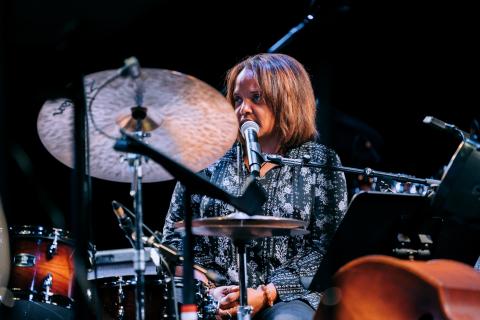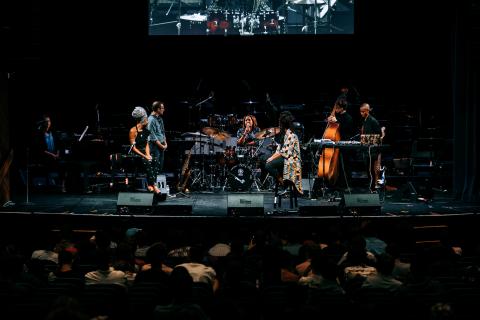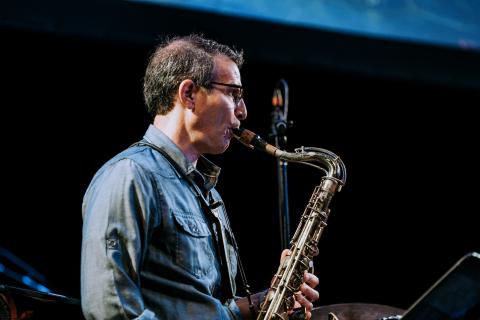'Feel the One': Terri Lyne Carrington and Others Get Mystical with Jazz Advice

Terri Lyne Carrington leads a performance clinic in the Berklee Performance Center for summer students.
Image by Ben Pu

Carrington's hand-picked ensemble
Image by Ben Pu

Vocalist Jazzmeia Horn
Image by Ben Pu

Val Jeanty on the turntables
Image by Ben Pu

Professor and saxophonist Rick DiMuzio
Image by Ben Pu
When looking for advice about performing jazz, it doesn't take long before answers move from practical suggestions to mystical reflections. This was the case at an August 8 performance clinic for summer program students led by Terri Lyne Carrington and an ensemble of special guests she handpicked just for the occasion, including Kris Davis (piano), Jazzmeia Horn (vocals), Akua Naru (spoken word), Rick DiMuzio (saxophone), Val Jeanty (DJ/turntables), and Charlie Lincoln B.M. '19 (bass).
For instance, when a student asked how to get comfortable playing in odd time signatures—that is, rhythms atypical to what one might hear in a standard pop or rock song—Carrington's initial answer was to just keep practicing. But when she took it deeper, students got a view into her more intuitive approach to jazz drumming overall.
Rather than counting beats, Carrington says she "feels the [musical] phrases. I let phrases tell me where the weight of the bar is. For a drummer, it’s good to practice in odd time signatures and practice not hitting any 1s. But you want to feel the 1."
In a way, the students got two kinds of advice, the short-term and the long-term. The practical pieces they can understand and apply right away. But what does "feeling the 1" actually mean? Chances are, they'll remember in a year or more, when they're deep into their own practice, and it could be the lesson that helps shape their musical identity.
Below are some takeaways from the clinic, abridged and edited for clarity.
How do you approach a new or particularly difficult piece of music?
Kris Davis: “If it’s too complicated, just narrow it down to the basics, which might just be playing the right hand, playing the chords and melody to simplify it. Especially in a sight-reading situation.”
Jazzmeia Horn: “It depends on what kind of setting. If we have some time, I may ask the pianist to go over the melody with me a couple times. But I like to know what a person was thinking when they were writing something so I can be able to tell the story differently. As a vocalist, we have something different than everyone else on the stage has, which is lyrics.”
What are your thoughts on how musicians find their own artistic voices?
Carrington: "You have to really go through a journey of really connecting to other people’s voices before you can find your own. You have to be mentored and introduced to other people’s paths, and then you can choose to do what you want."
Charlie Lincoln: "I only recently finished studying here. For me, it comes from learning from my teachers, but also just my experiences as a human being, because they all make your voice you. You almost don’t have a choice in it, because you have a set of experiences that no one else shares, and you can’t really hide that in the music. It’ll come out."
How do you add your own ideas to a piece without stepping on other people’s ideas?
Horn: "In life, in general, it’s always good to figure out how to not step on someone else’s toes. You have to be really comfortable with who you are and be honest with yourself. When you honor music and have a reverence for it, it’s going to be great. It’s why we have standards and rules to play, but we didn’t create music. It existed long before all of us in this room were born."
Val Jeanty: "For DJs, we’re just trying to add spices to the dinner. Also, working with certain sounds that are complementing what others are doing, you know, filling in words within the sentence. I try to keep my ears to what they’re doing so I can vibe with them."
What do you do to get comfortable playing in odd time signatures?
Davis: "Like anything, you just need to make it part of your practice. Then it becomes natural, like you feel in 4/4."
Carrington: "It took me a long time to get comfortable in odd signatures. But now I feel just as comfortable in 7 and 5 as I do in 4. I generally look at where I see the beat 'splitting.' I don’t count the beats—I feel the phrases. Feeling the phrases and melody—I let that tell me where the weight is, where I feel the weight of the bar. I also like to think in longer phrases. For a drummer, it’s good to practice in odd time signatures and practice not hitting any 1s. But you want to feel the 1. So if you get to the end of 5 or 7, you still want people to feel the 1."
How does your practice routine change over time?
Rick DiMuzio: "A lot of it is just getting on the instrument and right away making music. I’m really into that rather than the long-term exercise. The other thing I do is try to make mental puzzles for me to figure out on my instrument. For improvising, I want to feel free to switch it up and not play a pattern, so I’m training my mind to be able to flip quickly and adapt."



